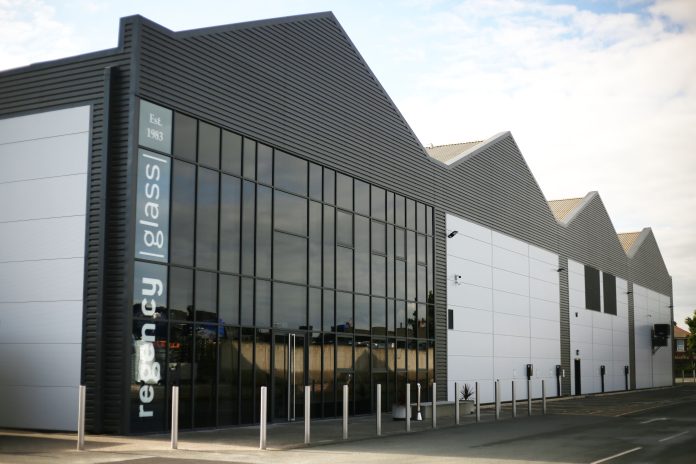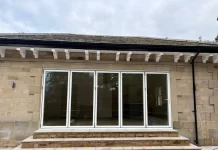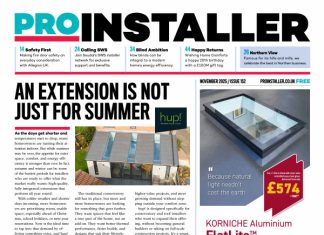Inside Regency Glass: The Quiet Force About to Change UK Glazing
For more than 40 years, Regency Glass has been doing things differently; quietly building one of the UK’s most forward-thinking glazing manufacturers. Based in Leigh, Greater Manchester, the company began life in 1983 in a modest 2,000 sq ft unit on Brown Street South, founded by four partners: Harold Beazant, his son, Darren Beazant, along with his close friends Terry Bates and Roy Hilton.
From the start, the focus was on long-term thinking: consistency, quality, and a deep understanding of the craft. Demand rose quickly, and in 1985, Regency moved to a 7,000 sq ft facility and installed its first vertical glass washing and sealant machines—boosting daily production capacity from 30 to 180 units. It was the first of many bold, well-timed moves that would define the company’s growth.
Over the decades, Regency’s reputation has been built not on loud marketing but on strong relationships and a reliable product. It’s still a family business. Darren remains fully involved in the company’s day-to-day running and strategy; but now joined by his son, Bradley Beazant, as Chief Development Officer, and his daughter, Natalie Hartley as Chief Financial Officer.
As the business prepares to launch a groundbreaking new product in early 2026 – an ultra-thin glass triple-glazed unit (TGU) with the potential to shift the entire UK market – those principles haven’t changed. But the scale certainly has…
A Business Built on Solid Ground
After further growth and another relocation in 1990 to a 15,000 sq ft site on Hope Carr Street (later expanded to 35,000 sq ft), Regency continued to focus on steady progress. In 1993, it was awarded the prestigious British Standards Kitemark Certification—one of the few UK companies at the time to hold this standard, reinforcing its reputation for quality and compliance.
In 2000, Regency made its first serious move into automation, investing in a dual glass cutting system, two automated IGU lines, and its own toughening plant, laying the groundwork for the digital transformation that continues to shape the business today.
A second 15,000 sq ft facility followed in 2015, just across the road, until, by 2019, Regency had outgrown both sites. That year marked another major turning point: the move to a 110,000 sq ft, purpose-designed facility at Bridgewater Business Park in Leigh. It became the new heart of operations and allowed for further investment in technology, systems, and skilled people.
That forward momentum has never stopped. The most recent leap came in 2025 with the announcement of Regency’s most ambitious project to date: a product and facility launch that will place it at the cutting edge of glazing in the UK.
Learning from the Global Market
While the UK glazing industry has been slow to fully adopt high-performance triple glazing, the US and European markets have taken a more progressive stance.
In countries like Germany, the Netherlands, and Sweden, high-efficiency glazing has long been seen as a necessity; not an upgrade. Across North America, too, particularly in climate-sensitive zones, triple glazing is fast becoming the new standard in both commercial and residential builds. And it’s not just about thermal performance, reduced noise, condensation resistance, and long-term energy savings are all driving factors.
Regency’s upcoming launch aims to bring the UK in line with these global trends, but with a crucial point of difference: practicality. By working with Corning Incorporated, a world leading innovator in glass, ceramics, and materials science, Regency is delivering a product that matches international performance levels, while remaining suitable for installation in existing UK window frames.
It’s a balance of performance, weight, and ease-of-use that could shift the UK market closer to the standards already seen across Europe and the US.
Technology That Enables Innovation
Delivering a product like this requires more than a great idea; it requires precision machinery, reliable partners, and advanced software that links it all together.
To support this transition into ultra-thin glass triple-glazed units, Regency has made multi-million-pound investments in world-class technology partners:
Corning Incorporated supplies the 0.5mm centre glass pane that enables Regency’s new TGUs. Developed on Corning’s proprietary fusion forming platform, this ultra-thin pane is thermally robust and strong enough to avoid the need for tempering—an industry first in UK manufacturing.
HEGLA has supplied thin-glass cutting tables and advanced glass handling systems (Sortjets), giving Regency the accuracy and efficiency needed to scale production while maintaining tight tolerances and reduced glass breakage.
Glaston provides the new thin triple TPS® IG line; currently the only one of its kind in the UK, alongside MULTI’ARRISSER edge processing machines and a new tempering furnace.
Jotika, Regency’s trusted software partner for over 30 years, is delivering a bespoke automation platform that will run every stage of production. From digital sorting to data tracking on the shop floor, it provides the visibility and control necessary for modern high-output manufacturing.
“These aren’t just technical upgrades,” says Bradley Beazant. “They’re a step-change in how we build, track, and deliver glass units. Automation helps us scale, but more importantly, it helps us deliver consistent quality every time.”
Factory Tour: Regency Headquarters
Clearview visited the Leigh headquarters to see the factory firsthand. The scale and precision of the site is immediately striking, but what stands out most is how seamlessly everything is integrated.
From the glass handling systems on the floor to the sleek, modern offices above, it’s clear that the layout and workflow have been carefully considered. The factory is immaculate – quiet, well-organised, and efficient. Everything, from raw material intake to product dispatch, moves like a well-oiled machine.
We were shown around by Darren. At every stop along the way, he knew exactly what was happening, why it was happening, and what might improve it. This is a man who knows his business from the ground up.
He moved from workstation to workstation like someone who could pick up the tools at any moment (and we wouldn’t be surprised if he did)!
And that focus on people is everywhere. The atmosphere is calm, professional, and happy. You can see how much care has gone into building a workplace where people want to stay. Staff are friendly, focused, and clearly take pride in their work.
Regency is currently rolling out a new in-house training programme, launched in 2024, designed to get every team member fully up to speed on new equipment, processes, and safety protocols. It’s not just about onboarding; it’s about building long-term capability across the entire workforce.
“You can invest in machinery,” says Steve Massey, Chief Sales Officer, “but if your people don’t understand how and why to use it, you’ve missed the point. We’re preparing our team for the future, because that’s what will ultimately sustain this growth.”
The Product That Could Change the Game
So, what’s coming in 2026?
The ultra-thin glass TGU from Regency Glass, developed in partnership with Corning, is a high-performance unit featuring a 0.5mm glass centre pane. It delivers U-values as low as 0.5 W/m²K, depending on unit configuration. It is only 5% heavier than conventional double-glazed units and 30% lighter than triple-glazed units. For many, it will be a drop-in solution—light enough for existing frames, tough enough for UK climate demands, and efficient enough to meet the next generation of building standards.
Full compliance testing is underway, and launch is expected in Q1 2026.
“This is the result of years of investment and development,” says CEO Darren Beazant. “We’ve built the infrastructure, the partnerships, and the production systems to support something truly different. It’s not about being first, it’s about being right.”
In the meantime, Regency’s focus remains clear: getting the product right, getting the people ready, and setting new expectations for what could be the biggest – or should that be slimmest – industry innovation for decades…











